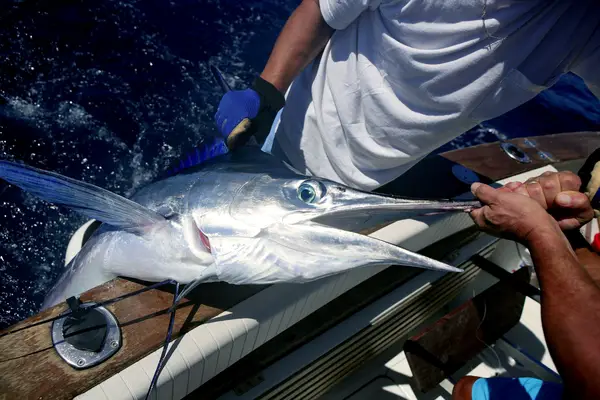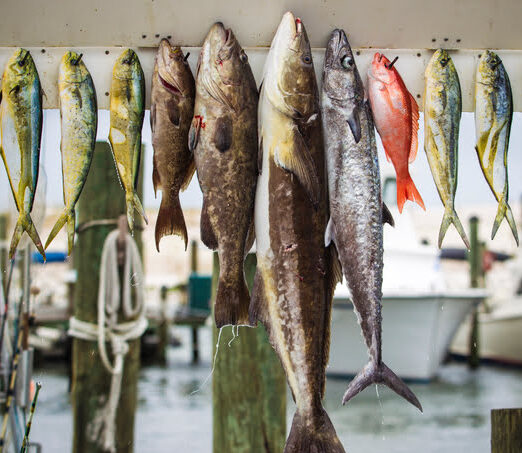The blue marlin is the largest of the four marlin species–blue marlin, black marlin, striped marlin, and white marlin. The blue marlin is a top predator and is a prized catch for sports fishermen around the world.
The blue marlin is found in both the Pacific and Atlantic oceans, sometimes growing up to 1,000 lbs, though more commonly growing to around 300 lbs.
Most of the time fishermen will catch and release these fish, but are blue marlin good to eat? And if so, what are the risks?
Table of Contents
- Can You Eat Blue Marlin?
- How Does Blue Marlin Taste?
- Is Blue Marlin Safe to Eat?
- Blue Marlin Nutrition
- How to Prepare Blue Marlin
- Final Thoughts
Can You Eat Blue Marlin?
Blue Marlin are edible, and in places like Japan they are considered a delicacy. However, in most Western cultures, the Blue Marlin is regarded as a gamefish, where it is often protected.
So, yes, you can eat Blue Marlin, and because they are found all over the world, consensus will vary on whether or not this is accepted regulated or common practice.

How Does Blue Marlin Taste?
The blue marlin is considered a delicacy in some cultures and it is one of the more expensive fish in the market, so many people expect it to have a unique, delicate taste.
Blue marlin tastes like swordfish or tuna but has a stronger, more intense, and gamier flavor. Some people think marlin tastes downright bad, others think it’s delicious, even eaten raw.
Blue marlin flesh is white to pale pink depending on their diet and firm like tuna. It can be used in all the same ways as tuna, for steaks, sushi, or various other uses.
Is Blue Marlin Safe to Eat?
One large blue marlin catch would certainly provide enough meat for potentially hundreds of meals, but you have to be careful about how often you consume marlin since it is a top saltwater predator.
Blue marlin is safe to eat but should be consumed with caution, and only on occasion. They are large saltwater predators, and in such fish, mercury and other heavy metal concentrations can be pretty high.
The general standard for acceptable mercury levels in retail seafood is 0.5 ppm.
The Cold Spring Harbor Laboratory published a study looking at the mercury level in 121 blue marlins, the total mercury level in the blue marlin ranged from 0.7 ppm to 12.2 ppm, way above the acceptable threshold.
Anyone with a sensitivity to mercury should avoid eating blue marlin. Even people without sensitivity should limit their consumption to once or twice a month. Some populations that should avoid mercury include:
- Pregnant women
- Breastfeeding mothers
- Small children
- People with a mercury allergy
- People with impaired kidney function
Should You Eat Blue Marlin?
The other important question is whether it is ethical to eat blue marlin. The blue marlin is currently considered a threatened species due to overfishing. Choosing to release the blue marlin that you catch can help maintain their population.
Whether or not eating blue marlin is ethical, it is ultimately up to you as a fisherman and as a consumer and the regulations where you are fishing.
Blue Marlin Nutrition
Blue marlin might be high in mercury, but it is also super nutritious. The calorie content of blue marlin is roughly 1 kcal per gram of raw meat. It is a pretty fatty fish, but low in saturated fat and an excellent source of protein.
Blue marlin meat is also a great source of micronutrients like omega-3, vitamin B6, vitamin B12, iodine, magnesium, and selenium.
How to Prepare Blue Marlin
Blue marlin can be prepared in any way that you might prepare other fish like tuna or salmon. It can be grilled, fried, smoked, or baked.
It can be eaten raw, though it may contain harmful parasites and bacteria, so if you are going to eat it raw you should make sure you prepare it properly, resting the fish in an icy brine after catching it and letting it freeze fully before serving.
A lot of people seem to agree that smoking marlin meat is the best-tasting method of preparation.
Blue marlin can be used in much the same way that you might cook salmon, tuna, or swordfish, working well as a steak, in sushi, ahi, fish tacos, and many other recipes.
Common Flavor Pairings
Blue marlin has a pretty strong flavor. The method of preparation can affect the flavors you might want to pair it with. Here are some flavors to try pairing with blue marlin next time you have a fresh filet:
- Lemon
- Lime
- Garlic
- Green onion
- Soy sauce
- Pineapple
- Mango
- Honey
- Red onion
- Bell pepper

Do You Love Seafood?
Final Thoughts
Blue marlin is a prized catch for fishermen that also makes for a super nutritious meal. It is an excellent source of protein, good fats, and micronutrients, but also high in mercury.
Blue marlin should only be consumed on occasion and also if you are not sensitive to mercury, are pregnant, or are breastfeeding.
In my opinion, there is plenty of other more abundant fish in the sea that taste better, and are more sustainable. If you’re lucky enough to catch a blue marlin, take a photo and release it for someone else to enjoy.
Thanks for reading.

Growing up in Florida, I’ve been surrounded by saltwater my entire life…and I love sharing my passion with others.
To learn more about why I started Saltwater Mecca, visit the ABOUT page.
Thank you for reading this article. Browse around & have some fun!